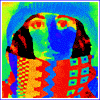 Two chromosome probes + nucleus counterstain
Two chromosome probes + nucleus counterstain
Modern DNA and fluorescence technology have made it possible to perform chromosome enumeration in interphase nuclei. Thus with a centromeric probe for chromosome 21 it becomes possible to look for trisomy by counting dots. This technology is suitable for a variety of clinical applications.
We have developed a completely automated system that can examine 500 cells in approximately 20 minutes to determine the number of dots in each cell nucleus. This system works with two fluorescent dyes - one for the hybridization dots (e.g. FITC) and one for the cell nucleus (e.g. DAPI). After the stage has moved to a new field the image is automatically focused, acquired by a Photometrics KAF 1400 camera, and then analyzed on a Macintosh II-fx computer. After the required number of cells has been analyzed, the user may interact to correct the computer by working with a gallery of the cell images. Typical accuracies are given below and are equal to panels of human experts (manual) and limited (ultimately) by the overlapping of dots in the 3D cell as seen through the 2D projection.
Chrom. 8 Cells 0 1 2 3 4 >4 Manual 2000 0.7% 2.6% 96.0% 0.7% 0.0% 0.0% Automated 282 1.1% 5.3% 93.3% 0.4% 0.0% 0.0% Auto+Corr 282 0.7% 1.1% 97.5% 0.7% 0.0% 0.0% Table 1: Percentage of cells containing N dots
 e-mail: young@ph.tn.tudelft.nl
Last update: 7 February 1995
e-mail: young@ph.tn.tudelft.nl
Last update: 7 February 1995